What’s in a word?
Magnus Hirschfeld
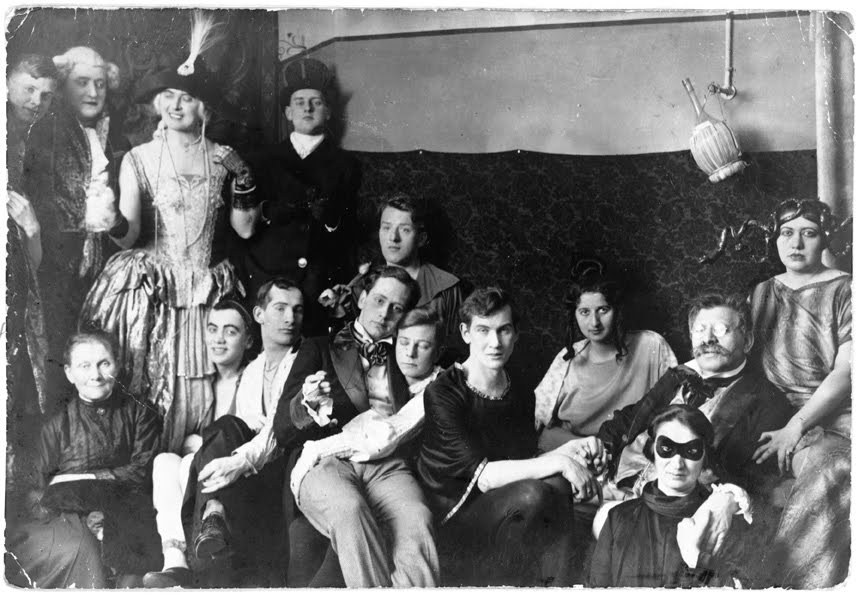

If the personal is political, then being trans has certainly become overly politicised in the last few months. Most transgender people just want to get on with their lives, not poke their heads above the parapet and be overtly public each Transgender Day of Visibility (#TDOV). 2014 was called the “transgender tipping point” and 2015 the year of transgender visibility, but 2017-18 is fast becoming the year of the war on women and trans.
The Gender Recognition Act (2004) aided that for some but not for all since it was not relevant to many transitioning people being mainly a requirement for pre-Equal, well Same-Sex anyway, marriage legal innovation. It is now front and centre of the new battle within feminism(s), the so-called “War on Women”, discussion of who or what is a woman, access to single-sex spaces and support services, and updates to the GRA.
“United We Stand, Divided We Fall”
We divide and misrule at our peril. Surely, to stand on the right side of history is to be on the side of progress towards human rights for all, not resisting them. Fourth-wave feminism understands intersectionality and trans sisters far more inclusively than second-wave feminism. This unfortunate fight is as much a battle within feminisms as it is between genders. Interestingly, just 59% of Mumsnet users call themselves feminists yet many have joined the trans resistance, i.e., are resisting the extension of gender-identity rights.
That said, there are peaceful cooperative ways to discuss legal provisions among those that are affected by the laws. Though, to be honest, since the majority of trans people don’t even bother with a Gender Recognition Certificate (GRC) and have been accessing the most appropriate spaces and services to their gender or stage of transition for years, it hasn’t been a ‘problem’ until now. Equally, over half-a-dozen countries have introduced gender self-ID since 2012 to no known problems.
The UK seems to be unique in perceiving it as a massive attack upon the rights of and risks towards women. It is also tearing the Labour Party apart, much as the current discussion of alleged anti-semitism within it is. The vitriol of calling both trans activists and ‘TERF’s (see below) ‘Fascists’ is laughable since the majority of those fighting each other are Socialists, Marxists, and generally people on the Left of British politics, several of whom have been suspended or ejected from the Labour Party over this issue.
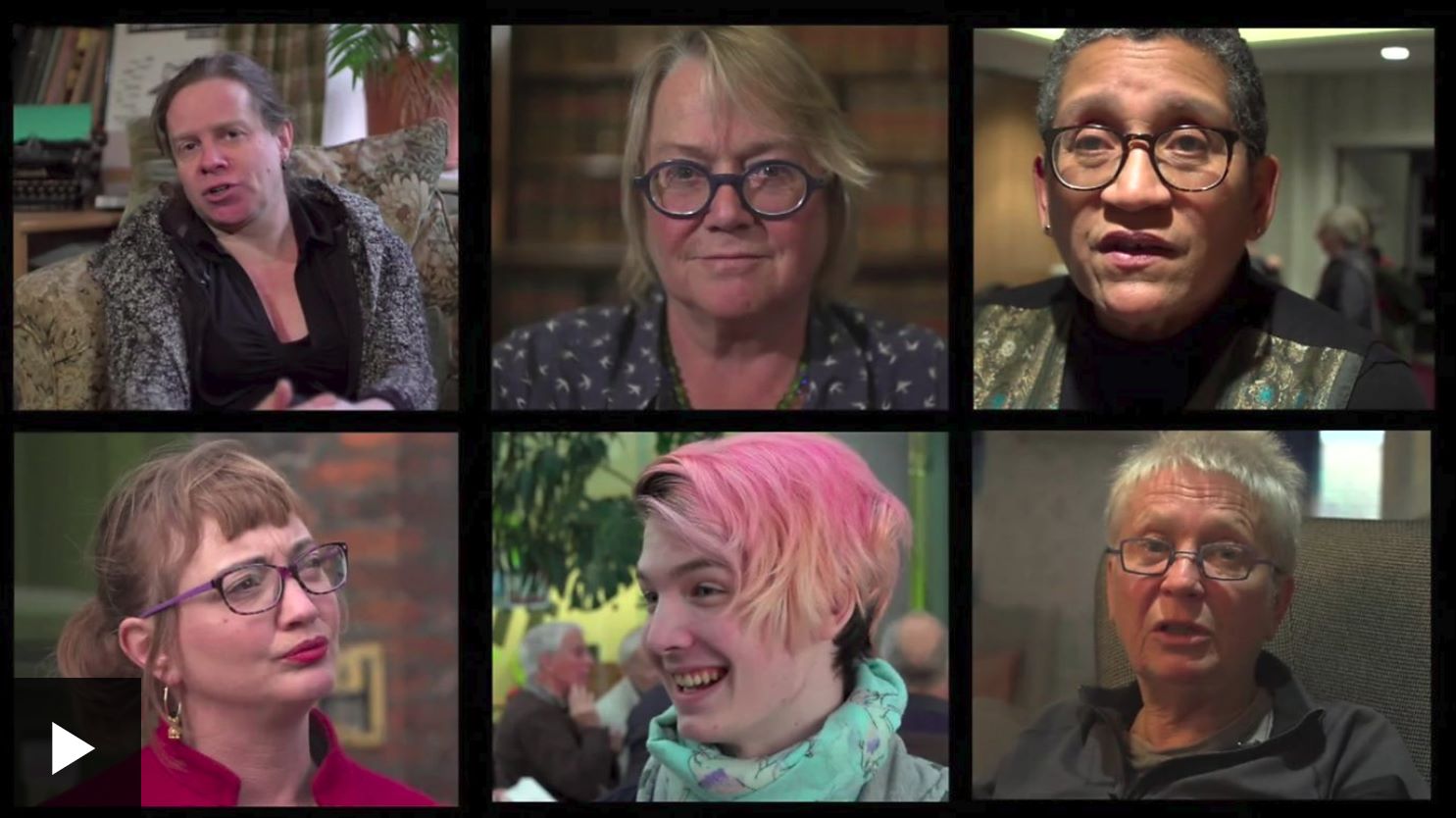
One vocal opponent (aka ‘TERF’ or a Radical Feminist who opposes the inclusion of trans women in female spaces and a term considered a slur by them despite its reasonably accurate abbreviated description) said this week that “Transgenderism wasn’t a thing. It didn’t exist 30 years ago.”
You will of course notice it was only lesbians and gay men. No trans. Transgenderism wasn’t a thing. It didn’t exist 30 years ago. I marched and campaigned against Section 28 as a young lesbian. #WarOnWomen #WarOnLesbians https://t.co/U2LtwA9532
— Anne Ruzylo XX ♀ (@sargesalute) March 28, 2018
That is akin to the Australian MP, Bob Katter, who recently claimed that LGBTI people had only been around for 60 years.
The willful ignorance of the history of transgender, third gender, and gender non-conforming individuals, is astonishing here. Not to mention, the nearly 50-years-ago trans-washing of the Stonewall riots (1969) and the numerous trans women and transvestites involved in protesting police violence and state criminalisation of LGBT people.
“people have been crossing gender boundaries for millennia and in all kinds of civilisations” – Christine Burns, History Today
All of these transgender people (a third of whom are trans men) and thousands more clearly existed 30 years ago and had surgeries more than 40 years ago:
Lili Elbe (1882-1931), Alan L. Hart (1890-1962), Michael Dillon (1915-1962), Roberta Cowell (1918-2011), Christine Jorgensen (1926-1989), Jan Morris (1926-), Jacqueline Charlotte Dufresnoy aka Coccinelle (1931-2006), Renée Richards (1934-), April Ashley (1935-), Lou Sullivan (1951-91), Caroline Cossey (1954-), Stephen Whittle (1955-).
“Respectful, calm debate is necessary. How society and medicine deal with gender requires critical review in terms of the potential for unintended harms, even if there are no easy answers.” – Dr Margaret McCartney: Medicine must do better on gender, BMJ
Ongoing research is clearly needed and continues to show a biological/nature more than social/nurture origin of gender identity without it being a question of respecting people’s self-identity, whether part of gender dysphoria or not – something I struggled with for years.
“Considerable scientific evidence has emerged demonstrating a durable biological element underlying gender identity. Individuals may make choices due to other factors in their lives, but there do not seem to be external forces that genuinely cause individuals to change gender identity. Although the specific mechanisms guiding the biological underpinnings of gender identity are not entirely understood, there is evolving consensus that being transgender is not a mental health disorder.” – Endocrine Society
We sorely need a message of mutual respect and inclusion not trans exclusion, but the way it is being discussed in a verbally violent polarised way is making it a debate about people’s identity, human rights, legal protections (I admit these go both ways within the EA, but not the GRA) and making it seem as if trans women don’t care about natal women’s rights to freedom from abuse.
Violence towards women is something that should not be projected onto the vast majority of trans women as if it were some kind of demonising 1980s homosexual moral panic.
We need to fight and protect against Domestic Abuse and Sexual Violence (DASV) together not apart.
No transfeminine person is trying to close down the discussion of the abuse of cis women and girls we are simply saying we need an expansion of that discourse to accommodate our experiences too – given that its the same men abusing us all often its in our shared interest!
— S H O N (@shonfaye) March 28, 2018
The majority of the victims are indeed women (including trans women) and the majority of the perpetrators are men – 90% of whom are known to victims, so the idea of ‘stranger danger’ and men using female self-identity to access women’s safe spaces is an extreme rarity and not indicative of real trans lives.
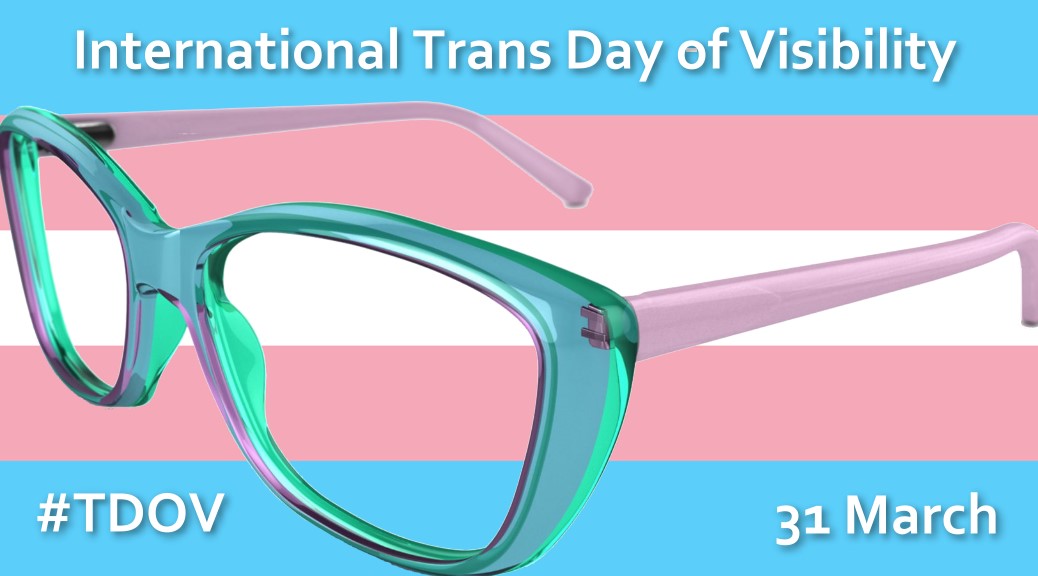
There is so much one could say about fear, one could write a book about it, indeed one is. So often fear runs, if not ruins, our lives. It did mine for 40 years. Learning to embrace fear, take the risks anyway, and have a walk on the wild side, was in part down to being ‘outed’ and then choosing to stay ‘out’ rather than retreat back into the closet of fear and self-loathing. I’ve been told I was lucky to be outed rather than face the fear of coming out! You learn to swim or run quickly when thrown to the sharks or wolves.
“fear is not something that I let rule my life, but gratitude is.” – Lana Wachowski
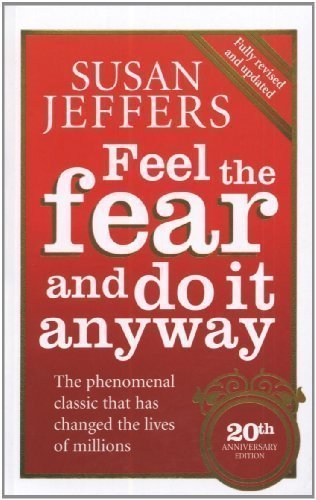
One of the most powerful books I’ve never read was the above titled volume by Susan Jeffers. Well I got as far as reading the front cover and never looked back. Nine years ago, in therapy, I paid approximately £15 a word to hear from my therapist at the end of each hour the two words, “Why not?” I spent each hour in fear and not a small amount of self-loathing, she responded, in essence, with “do it anyway”. Feed the fear – and you’ll end up paralysed and do nothing at all.
“The way to develop self-confidence is to do the thing you fear.” – William Jennings Bryan
Eckhart Tolle’s book was also influential and similarly unfinished-unread. My ‘now’ took years to find and only a moment to nearly kill off. It took all my courage to attempt suicide nearly 4 years ago. I was “in the moment” and exhausted of surviving not thriving. Each day it took all my energy just to keep going. Albert Camus wrote that:
“Nobody realizes that some people expend tremendous energy merely to be normal.” – Albert Camus
I’d given up trying to be normal, I had no energy left for the mask, vulnerability was easy, I had no defences left, and only one last resort.
In 2015 Lou Reed was inducted in the Rock and Roll Hall of Fame for a second time as a solo artist, the first time was as part of Velvet Underground. It was also the year that the “he [who] was a she” from his most well known Grammy Hall of Fame song -“Walk on the Wild Side“, Holly Woodlawn, died. From the appropriately named album, Transformer (1972), produced by David Bowie the song literally walked on the wild side, risking public outcry and censorship by referring to taboo topics such as transsexuality, male prostitution, colour and oral sex. Whilst British censors missed the references or ignored them, the US released an edited version of the single minus the oral sex reference. I want to live an unedited life!
Holly came from Miami, F.L.A.
Hitch-hiked her way across the U.S.A.
Plucked her eyebrows on the way
Shaved her legs and then he was a she
She says, ‘Hey babe, take a walk on the wild side’
He said, ‘Hey honey, take a walk on the wild side’Candy came from out on the island
In the backroom she was everybody’s darlin’
But she never lost her head
Even when she was giving head
She says, ‘Hey babe, take a walk on the wild side’
He said, ‘Hey babe, take a walk on the wild side’
The lyrics describe several of the colourful individuals who frequented Andy Warhol’s New York studio including transwomen and actresses Holly Woodlawn (who died this month after appearing as Vivian in two episodes of the Amazon television drama series Transparent about a family with a transgender father), Candy Darling (d.1974 aged 29), and Jackie Curtis (d.1985 aged 38). Warhol was an inspiration and mentor to Reed.
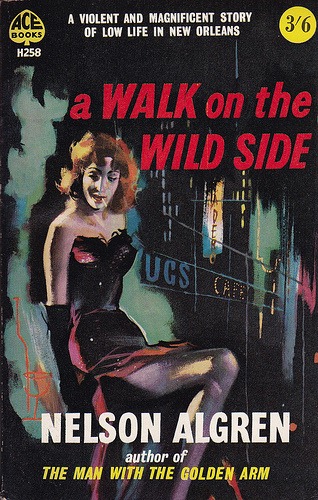
The title “Walk on the Wild Side” comes from a 1956 novel by Nelson Algren of which, he remarked:
“The book asks why lost people sometimes develop into greater human beings than those who have never been lost in their whole lives.”
The New York Times Book Review said of it: “His hell burns with passion for heaven.” It was also the source of Algren’s “three rules of life“:
“Never play cards with a man called Doc. Never eat at a place called Mom’s. Never sleep with a woman whose troubles are worse than your own.”
Lou Reed’s widow of a 21-year relationship and musician in her own right, Laurie Anderson, gave a speech on his behalf this year and quoted their three rules to live by:
“One. Don’t be afraid of anyone. Now, can you imagine living your life afraid of no one? Two. Get a really good bullshit detector. And three. Three is be really, really tender. And with those three things, you don’t need anything else.”
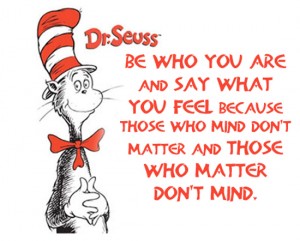
So much irreverent wisdom comes from Dr Seuss, not the least of which is this:
“Be who you are and say what you feel, because those who mind don’t matter and those who matter don’t mind.” – Dr. Seuss
The most important bit of which is “be who you are“, sometimes “saying what you feel” can be worth some discretion and discernment. A past girlfriend taught me a lot about authenticity and learning to be myself has been the best journey of my life, and I’ve travelled extensively, and not without the odd international incident in the Middle East and Africa!
[It is disputed whether this is an authentic Dr Seuss quote]
Whilst mid-life crises often afflict us in our forties, it is said that life begins at fifty. “A massive 92% of women in their 50s say they’re happier than they’ve ever been“. At 50, we’re over halfway and have learned hopefully to let go of the things that held us back thus far. For me, having led a double life until 40, it feels like I’m having a second bite of the cherry. If football is a game of two halves, then I’m in the mid-match break about to kick-off the second half.
“What would you be like if you were the only person in the world? If you want to be truly happy you must be that person.” – Quentin Crisp
I turn 49 in 2016, I’ll have been on female hormones (my male ones never worked anyway) for 6 years and I’ve finally plucked up the courage to go under the knife (6 Feb 2016) for what some would erroneously call cosmetic surgery – for many trans people, it’s life saving surgery. It’s actually a labioplasty not the usually requested vaginoplasty, and it’s probably not for the reasons one may suspect.
It’s more about a letting go of something than gaining anything new. But it’s the letting go, that was holding me back, leaving me in a literal “no man’s land” limbo the last decade.
One of my several psychiatrists (I’ve been married to one, and had four, along with a couple of psychologists) once said to me:
“You are the most reluctant transsexual I’ve ever met!”
I’ve tried everything from Christian deliverance and healing, denial, suicide, to sex and body workshops, self-development work, and yet more therapy and therapists, to avoid being me. I’m not expecting surgery to change me, rather to free myself up from some unnecessary encumbrances, literally! I dealt with the emotional baggage some time ago, now for the physical baggage. I expect to be travelling lighter from now on.
“Sorry for being me but I have great difficulty being anybody else” – Spike Milligan
As Oscar Wilde never said, instead it appears to have been some millennial advertising slogan, “Be yourself, everyone else is taken”. What Oscar did say was:
“One’s real life is so often the life that one does not lead” (1882)
“Man is least himself when he talks in his own person. Give him a mask, and he will tell you the truth.” (1890)
Well, I tried the mask and he lied. Dropping the public persona and allowing the vulnerable inner me to step out and lead my real life. It has been undeniably scary but a ride nonetheless, and the journey is only just beginning. 2015 feels like it is the end of the beginning, or the beginning of the end of my old life. 2016 will allow me to move forward with a bit less of my body and a whole lot more of me.
The Eurovision Song Contest was established post-War to bring nations together in peaceful pop appreciation but as ‘greater’ Europe’s nations (including Russia and Israel) battled it out over national pop songs (mostly sung in English!) on 10 May, new conflicts arose.
 First, there was the new enmity between Russian and Ukraine and the break-up of the former Warsaw-pact voting block. Second, there was the usual analysis and outcry at nationalist and neighbouring countries mutual self-interest voting patterns, not to mention vast divisions between the newer 50/50 split between public and professional jury votes.
First, there was the new enmity between Russian and Ukraine and the break-up of the former Warsaw-pact voting block. Second, there was the usual analysis and outcry at nationalist and neighbouring countries mutual self-interest voting patterns, not to mention vast divisions between the newer 50/50 split between public and professional jury votes.
Finally, there was the homophobia and indeed, transphobia, of some nations (Belarus, Russian and even some Austrians) complaining about Austria’s label-defying gay genderqueer drag diva Conchita Wurst, who went on to win the contest.
Russia-Ukraine | Reaction | Voting | Camp/Queer History | Conchita Wurst | Bearded Women

2014’s Eurovision Song Contest (ESC) in Copenhagen, Denmark, was the 59th competition, having begun in 1956. This year, 37 nations, competed, and it top-ten trended on Twitter most of the week, such is the European, if not international following of the entertainment extravaganza.
Tuesday’s semi-final had more at stake than music as rival posturing nations Russia and Ukraine continued their war of words.
Both Russia and Ukraine made the semi-finals with Ukraine’s entry drawing cheers and Russia’s, boos. Eurovision 2014’s tagline #JoinUs had a darker new meaning as Russia wants Ukraine to “join us” having already taken Crimea to a dubious vote – just like Eurovision!
One of last year’s Eurovision stories was Twitter top-trending as hundreds erroneously re-tweeted a BBC story about Azerbaijan’s failure to nominate any points to Russia’s entry in the Eurovision song contest and Russia’s foreign minister calling this “outrageous”! Except this was 2013, and a conspiracy theory at that, with the report that Azerbaijan’s President subsequently ordered an inquiry into how its votes for Russia apparently went missing. In the game of Eurovision “Risk” Russia had given Azerbaijan’s entry maximum “douze points”.
This year, Russia’s entry, the Tolmachevy Twins, aged 17, seemed perfect Eurovision fare, beautiful on the eyes and ears, a popular choice – apart from being Russian. Their song and teenage innocence with respect to all the international politics meant they were received well until they progressed to the final and were booed by the Danish and international semi-final and final audiences, who seemed strongly anti-Russia’s stance against gay rights, Crimea and the Ukraine. During the awarding of points almost every award of any points to Russia was greeted with jeers rather than cheers as the voting public punished Putin for Russian territorial aggression and anti-LGBT laws.
Ukraine’s own entry, Mariya Yaremchuk, also qualified for the final with the added visual drama of a suited male dancer running inside a giant hamster wheel to her song “Tick-Tock”.
In the end, Conchita Wurst of Austria won by a large margin 290pts (beating Netherlands 238pts), but Ukraine, with 113 points to Russia’s 89 points, will be pleased it came 6th over Russian’s 7th place! Ironically, Russia gave Austria (5pts) one more point than it gave to Ukraine (4pts).
Russian news sites during the week reported on the respective nations’ entries as “aggressive”, “militant” or about supposed political messages hidden in the songs.
The morning after Eurovision 2014 was won by gay genderqueer drag artist from Austria Conchita Wurst had Russian politicians reaching new lows of homophobia and European “liberal” condemnation.
The Russian Deputy Prime Minister, Dmitry Rogozin, tweeted that the Eurovision result “showed supporters of European integration their European future: a bearded girl.”
“Евровидение” показала евроинтеграторам их европерспективу – бородатую девочку pic.twitter.com/NveBKtgQkQ
— Dmitry Rogozin (@Rogozin) May 11, 2014
According to TheJournal.ie, another Russian politician, the ultranationalist leader of the Liberal Democratic Party (LDPR), Vladimir Zhirinovsky, told Rossiya-1 state television:
“There’s no limit to our outrage. It’s the end of Europe. It has turned wild. They don’t have men and women any more. They have ‘it’. Fifty years ago the Soviet army occupied Austria. We made a mistake in freeing Austria. We should have stayed.”
Zhirinovsky has been described as “One of the most enduring fruit loops in Russian politics” – note that was ‘enduring’ not endearing. He is stubbornly sexist, homophobic, racist, anti-Western. He has called for the deportation of Chinese and Japanese people, threatened a female journalist with rape, and crazily suggested that the British royal baby would suck Russian blood!
Russian hip-hop rapper Timati had over 76,000 likes in just 15 hours for his Instagram post about Conchita Wurst in which he wrote that her win was symptomatic of a “complex mental disorder of modern society”. He went on to bemoan having to explain gay kissing to children, bearded trans – “and that’s supposed to be normal”,and to praise Putin for banning LGBT Pride Parades.
Russia’s reactions are somewhat, ironic and hypocritical given that in the 2003 Eurovision Contest they were represented by faux-lesbian t.A.T.u. and their same-sex kissing. Again, in February, at the Sochi Winter Olympics the Russian Olympic team marched out to the music of t.A.T.u.’s Lena Katina and Yulia Volkova, dressed as schoolgirls, kissing in the rain.
Eurovision’s extra political undercurrent this year is nothing new as block-voting has been allegedly going on for decades, whether Greece-Cyprus, Scandinavian, Balkan or Warsaw pact blocks. Whilst mutual voting may have helped Ukraine win in 2004, Russia in 2008, and Azerbaijan 2011, it seems that for many former Soviet Union/Warsaw Pact countries cooperation is now over with Russia’s perceived aggression in the real world outside of camp pop culture.
Eurovision is no stranger to camp, drag or trans artistes, such as Israel’s pioneering 1998 trans winner, Sharon Cohen performing as Dana International. Sharon had come out as transgender aged 13 and had transsexual surgery (SRS/GRS), aged 21, in London in 1993. Initially, she had performed as a drag act but she had also felt female from a very young age. Her background was Romanian and Yemenite Jewish and her Eurovision entry received strong opposition from Orthodox Jews, calling her “deviant” and other traditionalists who attempted to block her competing in Eurovision as Israel’s entry. She said after winning, “I want to send my critics a message of forgiveness and say to them: try to accept me and the kind of life I lead. I am what I am and this does not mean I don’t believe in God, and I am part of the Jewish Nation.” Winning meant Israel hosted 1999’s Eurovision and again conservative forces attempted to keep “sexual perversion” out of Israel’s “holy city”, Jerusalem.
Eurovision 2002 saw Slovenia set feathers ruffling by entering the first drag act, rather than a transwoman, a trio called Sestre.
In 2007 double divas ruled the competition as Denmark’s DQ performing “Drama Queen” came from the back to pip Ukraine’s own Dolce & Gabbana wearing drag act Verka Serduchka to win the contest. Verka, a.k.a. Andriy Danylko, had to overcome Ukrainian opposition to their act in the form of radio protests and statements in the Ukraine Parliament labelling him as “grotesque and vulgar”.
Last year, Turkey allegedly refused to broadcast the show because of a same-sex kiss by Finland’s entry.
This year’s Eurovision has seen Austria’s innovative genderqueer entry, Conchita Wurst, steal the show and go on to win it. She has not been without controversy, though, and has attracted her own oppositional battles, but along gender/sex/uality lines not state sovereignty lines as with Russia and Ukraine.
Vienna-based Tom Neuwirth performed as a “drag” persona Conchita Wurst – a thinly veiled euphemism for “Vagina Sausage”. What makes this creation stand out further is that Conchita sports a very neat and kempt beard! Well, thickly brushed on eye shadow to be accurate.
It is ‘said’ that Tom-Conchita identifies as “gender neutral”, “trans” and prefers female pronouns. “While identifying as gender neutral, she uses female pronouns to describe herself but still likes to play with drag, satire and gender identity.” Hence most labels struggle to fit them, somewhere between gender identity and gender performance, neither traditional drag nor typical trans, male nor female, seem to 100% fit, and their preference for “gender neutral” seems best, whether that extends to non-binary is something we just don’t know.
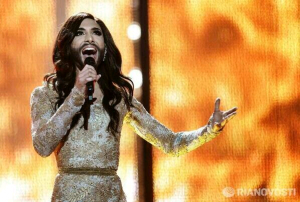 Tom-Conchita’s Eurovision official profile page gets all the gender pronouns mixed up – and some people are still mixed up in trying to define her, I say, let her stay unboxable.
Tom-Conchita’s Eurovision official profile page gets all the gender pronouns mixed up – and some people are still mixed up in trying to define her, I say, let her stay unboxable.
No doubt some trans may be horrified by Conchita’s depiction of a “bearded lady” after issues with British TV’s Little Britain and Paddy Power’s transphobic “Spot the Tranny” competition. Conchita is happy to use the term “bearded lady” and adopts it as a “symbol of tolerance”. Asked what was special about Conchita’s entry, she said:
“For me the most special and honoring thing is that Austria shows tolerance and acceptance and I’m so happy to be this statement. I’m allowed to be the voice of their beliefs during this time and this really makes me very proud. We, and not at least myself, want to stand for a society without hate and discrimination. And if I’m honest, I think everyone of the contestants should stand for the same, cause we are joining a very opend minded project, so they should be open minded too…I really hope that I get the chance to change some minds all around Europe. I want to show them that you can look whatever you want and that everybody must have the right to live their life however they want it, if nobody gets hurt…I really want to convince them to be the best version of themselves rather than a bad copy of someone else! You can do whatever you want if you’re not hurting anyone.” [sic]
No stranger to controversy and prejudice, their involvement has attracted protests from homophobes and transphobes in Austria, Belarus and Russia, describing the competition as full of “European liberals” and “a hotbed of sodomy”. One Russian politician has called Conchita an “Austrian freak” and that “the future of our children depends on us” banning them from Eurovision. Armenia’s entry, Aram Mp3, described Conchita as “not natural” and offered to, “help her to … decide whether she is a woman or man”. Conchita responded with:
“I am a working woman/queen and an incredibly lazy young man in my free time and that is not going to change. If you have problems understanding that, then I would be happy to sit down with you and explain it to you in more detail. And with your homophobic comments, that is a conversation that we really need to speak about.”
Curiously, trying to find the exact source of Conchita’s response results in about 50 references to “working woman” and some 80+ to “working queen”. For instance, the HuffPost version has “I told him I don’t want to be a woman. I am just a working queen and a very lazy boy at home.” For a transwoman, a beard and a name with all the sexual innuendos Conchita Wurst has would be somewhat strange. Yet for a drag queen she seems to prefer life as a woman to that of a gay man. Whatever her labels and self-identity she is free to be who she is and/or wants to be. Conchita said:
“I feel more comfortable in this persona than being a boy at home … Being a teenager, a gay teenager, in such a small village is not that much fun. I am part of the gay community and most gays have a similar story to mine.”
Even in liberal California a Psychology Professor polled their class and 77 out of 138 said they found Conchita’s appearance “offensive or confusing”. Obviously, it is confusing, but there is a big leap from confusing to offensive. They also said:
“I think having a beard and having a feminine body at the same time the singer shows that he/she is still in the process of transformation (from male to female, Which is ok) …[but] … there are only two kinds in all species in the world………male or female? Anything in between is considered unusual… But in Conchitas case, I think he/she is crossing a very thin line which actually is not only unethical, (and I don’t care about the ethical part) but just confusing, absurd and almost unexceptable. Every single one of my gay friends thinks this way and I can prove it… Even my gay friends are offended by Conchhita. Actually they’re furious and angry at her.” [sic].
Conchita’s song called “Rise Like a Phoenix” can be heard here:
You can follow Conchita on Twitter or on Facebook, where she has 40,000 likes, around the same number as the Austrian facebook campaign against her which also attracted nearly 5000 signatures on change.org. Conchita summed up her motivation and message in a Radio Free Europe interview:
“My stance is that I fight for something positive rather than against something negative. I was always an outsider and I was confronted with discrimination. I don’t want this to happen to the next generation.”
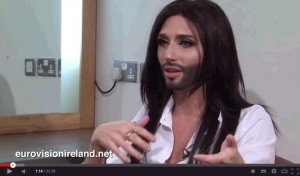 Garrett Mulhall Of EurovisionIreland.net interviewed Conchita in November 2013 about her music and mission, ideology and identity, and she had this to say:
Garrett Mulhall Of EurovisionIreland.net interviewed Conchita in November 2013 about her music and mission, ideology and identity, and she had this to say:
[Conchita] “I have arms like a man, face like a girl, and also the beard, and I told them that this is, that there are people out there who are in between you know and I took them by the hand and I said you are here (the boy), the girls – here, and I am just in the middle…I think they understood that there is more than a surface of a person” (11m27s)
[Garrett] “I think you being at Eurovision is a pivotal point in Eurovision’s history, and it’s one that I’m very glad about, because, … Eurovision was established so long ago to bring a war-torn Europe together and times have moved on now where we’re trying to bring different people from social backgrounds or gender backgrounds or … whatever, … we don’t want to label people anymore, and tolerance is obviously a very important thing to you…” (12m20s)
Many have challenged her sexuality, gender identity, presentation and pronouns – She prefers “she” and “her” and is more comfortable as Conchita than Tom the “lazy boy” she dresses down as, however. her male partner didn’t know she was Conchita as well for a week or two.
Our need to label, even as minority communities, to claim, correct or reject, her personal expression, is indicative of a common human need to categorise, define and then decide whether they are a threat or not. She is a threat to stereotypes of man, woman, gay, trans, drag queen, for she does not conform to any in a traditional way. Some trans are up in arms over her beard and for the possible inclusion of a drag queen under their umbrella. Some gays see her as too female too often. Some women oppose her use of female pronouns and, again, the beard.
By her own description, she does not fit, but is “in between”, non-binary, and that she is more than just her surface. By her own admission she is not transgender, or at least it is more artistic expression, “I am a drag artist”, she says.
Indeed, in performance, and initially in the interview there is a touch of drag and gender performance about her, but as she settles into talking about equality and acceptance, the seriousness takes over and her feminine expressions remain, but more integrated less performative. These are not judgements or criticisms, for I find the more I listen to her the more I love her. We all need to get beyond the “surface” of a person and cease visual and labelled judgements.
Her goal according to the Irish interview (around 15-17 mins in) is for people to engage and talk about difference, to start to think, to accept – whether they like/love it or not. That much she can 100% regard as being successful in. People are talking – good for her! Conchita made it through Thursday’s semi-finals to Saturday’s live final after some delays down in part to questions as to whether Belarus had even broadcast her act, such is the opposition to her from some quarters. Indeed, after her win on May 10, she was condemned by the Russian Orthodox Church and many in Russia were shaving their beards off in protest – the men that is!
After Eurovision Conchita Wurst has been in great demand and was the headline performer at 2014’s Pride show in Trafalgar Square, London on 28 June. She was introduced by veteran gay rights activist and Magneto/Gandalf actor Sir Ian McKellen with the words:
“Showbusiness has always led the way when it comes to the freedom to be yourself. So, Conchita is following in the footsteps of our predecessors. There is a long tradition of outrageousness and confidence that performers embody, and that has an enormous impact. It clears the way for others to dare to be themselves. She has done just that.”
Conchita Wurst said before the parade how much she was “looking forward” to it and what Pride meant to her:
“Let us be proud about who we are and let us give a statement for love, respect and tolerance. And most of all let us be proud and think about those LGBTI people around the world, who can’t make a Gay Pride in their countries.”
Chair of London LGBT+ Pride, Michael Salter said:
“Conchita is an incredible example of the power of having the #freedomto be oneself. Winning Eurovision, she raised the profile of the LGBT+ community across a continent and sent an important political message. We are thrilled that she is coming to celebrate Pride in London.”
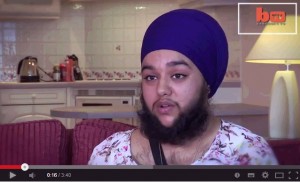 All of this recalls the recent challenge to not only typical female gender presentation but also traditional Sikh expectations by Balpreet Kaur who has Polycystic Ovary Syndrome (PCOS) but has embraced her facial hair which it caused and let it grow to a full beard. Her baptism into the Sikh faith now requires her not to cut it. At school and online she was bullied to the point of self-harm and felt suicidal but found huge public support and acceptance for her brave stand. She has now accepted herself, her beard, and discovered a new confidence and humour – read more about her.
All of this recalls the recent challenge to not only typical female gender presentation but also traditional Sikh expectations by Balpreet Kaur who has Polycystic Ovary Syndrome (PCOS) but has embraced her facial hair which it caused and let it grow to a full beard. Her baptism into the Sikh faith now requires her not to cut it. At school and online she was bullied to the point of self-harm and felt suicidal but found huge public support and acceptance for her brave stand. She has now accepted herself, her beard, and discovered a new confidence and humour – read more about her.
[Parts of this article were initially posted here and here.]
Yesterday was the International Trans Day of Visibility (ITDoV/TDoV), as such I shrugged off my Harry Potter cloak of invisibility and ‘outed’ myself – oh no I did that 7 years ago, or rather my partner did that for me! Ironically, as transgender people we are often all too visible to society if we do not “pass” well – something that many trans aspire to and many find psychologically and socially distressing if not achieved. What is true, however, is that for every trans you notice another 9 or 99 are invisible, because they’ve either disappeared into the general hubbub of society and are accepted as people first, and gendered persons of trans history second, or, they may be part of the invisible iceberg of trans not yet out. 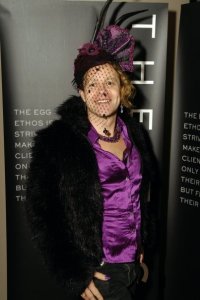
This latter group, for whom gender identity becomes a self-aware issue typically by the age of 7 may on average stay hidden till coming out in their 40s. If families, partners, media and society were more accepting, less judgemental and ridiculing, then I am quite sure more would be out and visible. Perhaps, like International Coming Out Day, today is a day we can celebrate increasing safety for more trans to come out, not to be ‘outed’ as I was at first. People call me brave for being ‘out’, but I had no choice, being ‘outed’ to friends and family by my then partner. By then it was “in for a penny in for a pound”, a “sink or swim” choice.
Transgender Day of Visibility was started in 2009 by trans activist Rachel Crandall-Crocker, of Michigan, USA. It began as a Facebook event but grew to encompass all kinds of awareness and visibility-raising events.
Events on the day have included protests, actions, sit-ins, poetry, educational and social events, anything to show that the transgender community is a valuable part of society to be accepted and respected.
These positive publicity events are in contrast to the annual International Transgender Day of Remembrance (TDoR) held each 20 November where the tone is remembrance and commemoration of all those who’ve lost their lives, often violently, for being out or outed as trans. A Transgender Awareness Week has now formed in the week leading up to TDoR.
The prevalence of transgender people in our communities is a hotly debated subject and one which is subject to several studies that are each seen as underestimates by the next one to be carried out. Numbers are made all the more likely to be on the low side by the difficulty of polling people who are not out or maybe trying to live discreet post-surgical lives. Surgery figures may only reflect those via recordable national health clinics and not those going privately or abroad for surgery.
Similarly being trans covers everyone from transsexuals at various stages of hormonal and/or surgical transition, occasional and full-time crossdressers/transvestites, and some trans who identify as a third or non-gender outside the binary of male and female.
Whilst transsexuals may represent just 0.1% of the population, non-surgical trans may be 1% or higher as only a fraction pursue surgery and many are not ‘out’ to everyone. Figures as high as 1.5% have been quoted and the numbers coming out each year are escalating as exponential rates as it becomes more safe to do so. I live in a city of 200,000 adults and know over 100 local trans personally and of another 50-100+. There will obviously be those I don’t know and those not out yet so 1-in-1000 is a gross underestimate and yet that is a figure considered high by the NHS.
More prevalence research data here: http://www.gires.org.uk/assets/Medpro-Assets/GenderVarianceUK-report.pdf http://tgmentalhealth.com/2010/03/31/the-prevalence-of-transgenderism/ http://en.wikipedia.org/wiki/Transsexualism#Prevalence
The best thing you can do on this Transgender Day of Visibility and on every day following it is to reduce the tacit acceptability of transphobia in humour, toilet/bathroom access, and general gendered sexism and stereotyping. Allowing teens to grow up in the gender or expression they are comfortable with. Encouraging teens to be free to be tomboys and/or effeminate, irrespective of birth gender.
In another article Mey, an Idaho based Latina transwoman activist, outlines 15 ways to support trans people on the day of visibility and every day.
In the UK we have many visible trans already such as the comedian and actor Eddie Izzard, Turner Prize winning artist and speaker Grayson Perry, LGBT Pink List topping radio and print journalist Paris Lees, several contributors to the Guardian newspaper such as Jane Fae, Juliet Jacques, Roz Kaveney; Prof of Equalities Law at Manchester Stephen Whittle, Christine Burns and many more besides. In business there is Kate Craig-Wood, an entrepreneur and founder of one of the UK’s largest IT groups. There’s comedians Bethany Black and Andrew O’Neill, and several other comics too, musicians like CN Lester, Thomas Dolby’s son Harper, and a magician, Fay Presto. I could go on and know of 100s of trans lawyers, doctors, activists in public life here in the UK alone.
In 2011 Channel 4 broadcast My Transsexual Summer and launched 7 British trans people into the limelight including friends of mine like Donna Whitbread, as well as Maxwell Zachs, Sarah Savage, Drew Ashlyn Cunningham, Lewis Hancox, Raphael Fox, and Karen Gale. Big Brother (UK and worldwide) has seen several trans winners and contestants including Nadia Almada, Luke Anderson, Lauren Harries, Alex Reid and Rodrigo now Rebekah Lopez.
April Ashley, Jan Morris and Caroline Cossey are all well known British women with open transgender histories. In the US Janet Mock, among others have blazed the way by being out and public in their defence of being themselves. Recently we’ve seen big names like Lana Wachowski of the Matrix films, Chelsea Manning of Wikileaks fame, Cher’s son Chaz Bono, and Laura Jane Grace of Against Me. Actors like Alexis Arquette, Candis Cayne (“Dirty Sexy Money”), Laverne Cox (“Orange is the New Black”) and Calpernia Addams, who recently advised Jared Leto on his Oscar winning role in “Dallas Buyer’s Club”. Nor is “Gender Outlaw” author Kate Bornstein to be forgotten. Dr Marci Bowers, is an American gynaecologist and surgeon and actually carries out gender/sex-reassignment surgery. There’s the US biologist and author of “Evolution’s Rainbow” Joan Roughgarden.
The names above are just a sprinkling of the hundreds of thousands of out trans people worldwide and possible even over a million or more yet to come out, I mean 1-in-1000 it would be 6-7 million worldwide. Here’s hoping that more trans feel comfortable being more visible each day as that would not only make their lives happier but society itself all the more accepting and embracing, which is good for everyone. We are not invisible nor scary – but a little afraid ourselves, talk to us. For more information about the transgender spectrum visit www.genderagenda.net.
Transgender Visibility Day (31 March) Bisexual Visibility Day (23 September) Intersex Day of Awareness (26 October) Transgender Day of Remembrance (20 November)
best herbal supplements sex drive cbd gummies and erection extenze fast acting male enhancement long lasting sex without pills top gun male enhancement pills safety of rlx male enhancement does maca root help with sex drive rhino 200k pill review male sex pills onenight stand over the counter penis enlargement pills pills for stronger erection otc alpha q male enhancement reviews 10 pack male enhancement pills top 10 natural erection pills medically enlarging a penis does male enhancement stiff nights work what drugs can help with erectile dysfunction vegas strips male enhancement reviews diet while using ed pills consumer reports male enhancement productsedema from blood pressure medication low blood pressure reasons and treatment which blood pressure medications protect kidneys blood pressure medications and weight gain alcortin blood pressure medication what is a cheaper version of bystolic blood pressure medication blood pressure medication at night time cinnamon blood pressure medication b blood pressure medication how to lower high blood pressure fast without medication naturally low blood pressure and chicago medical proven ways to lower your blood pressure without medication high blood pressure medication clonidine what are common side effects of high blood pressure medication medications taken for high blood pressure do high blood pressure medications thin the blood high blood pressure hypertension diagnosis and treatment mayo mayo clinic accent seasoning and blood pressure medication prednisone and blood pressure medication can i just stop taking my blood pressure pills